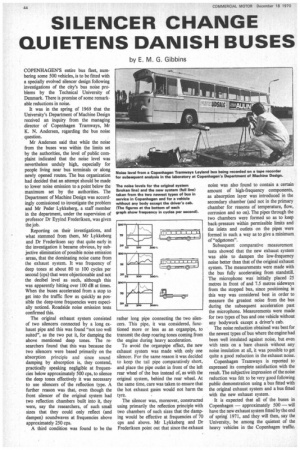SILENCER CHANGE QUIETENS DANISH BUSES
Page 46

If you've noticed an error in this article please click here to report it so we can fix it.
by E. M. G. Gibbins
COPENHAGEN'S entire bus fleet, numbering some 500 vehicles, is to be fitted with a specially evolved silencer design following investigations of the city's bus noise problems by the Technical University of Denmark. There is promise of some remarkable reductions in noise.
It was in the spring of 1969 that the University's Department of Machine Design received an inquiry from the managing director of Copenhagen Tramways, Mr K. N. Andersen, regarding the bus noise question.
Mr Andersen said that while the noise from the buses was within the limits set by the authorities, the level of public complaint indicated that the noise level was nevertheless unduly high, especially for people living near bus terminals or along newly opened routes. The bus organization had decided that an attempt should be made to lower noise emission to a point below the maximum set by the authorities. The Department of Machine Design was accordingly cornissioned to investigate the problem and Mr Peder Lykkeberg, a staff member in the department, under the supervision of professor Dr Eyyind Frederiksen, was given the job.
Reporting on their investigations, and what stemmed from them, Mr Lykkeberg and Dr Frederiksen say that quite early in the investigation it became obvious, by subjective elimination of possible noise emission areas, that the dominating noise came from the exhaust system. It was frequency of deep tones at about 80 to 100 cycles per second (cps) that were objectionable and not the decibel level as such, although this was apparently hitting over 100 dB at times. When the buses accelerated from a stop to get into the traffic flow as quickly as possible the deep-tone frequencies were especially noticed. Roadside noise emission tests confirmed this.
The original exhaust system consisted of two silencers connected by a long exhaust pipe and this was found "not too well suited", as the two put it, for damping the above mentioned deep tones. The researchers found that this was because the two silencers were based primarily on the absorption principle and since sound damping by absorption is, they contend, practically speaking negligible at frequencies below approximately 500 cps, to silence the deep tones effectively it was necessary to use silencers of the reflection type. A further reason was that, even though the front silencer of the original system had two reflection chambers built into it, they were, say the researchers, of such small sizes that they could only reflect (and dampen) soundwaves at frequencies above approximately 250 cps.
A third condition was found to be the rather long pipe connecting the two silencers. This pipe, it was considered, functioned more or less as an organpipe, to transmit the deep roaring tones coming from the engine during heavy acceleration.
To avoid the organpipe effect, the new exhaust system was made with only one silencer. For the same reason it was decided to keep the tail pipe comparatively short, and place the pipe outlet in front of the left rear wheel of the bus instead of, as with the original system, behind the rear wheel. At the same time, care was taken to ensure that the hot exhaust gases would not harm the tyre.
The silencer was, moreover, constructed using primarily the reflection principle with two chambers of such sizes that the damping would be effective at frequencies of 70 cps and above. Mr Lykkeberg and Dr Frederiksen point out that since the exhaust noise was also found to contain a certain amount of high-frequency components, as absorption layer was introduced in the secondary chamber (and not in the primary chamber for reasons of temperature, flow, corrosion and so on). The pipes through the two chambers were formed so as to keep back-pressure within permissible limits and the inlets and outlets on the pipes were formed in such a way as to give a minimum of "edgetones".
Subsequent comparative measurement tests showed that the new exhaust system was able to dampen the low-frequency noise better than that of the original exhaust system. The measurements were made with the bus fully accelerating from standstill. The microphone was initially placed 25 metres in front of and 7.5 metres sideways from the stopped bus, since positioning in this way was considered best in order to measure the greatest noise from the bus during the subsequent acceleration past the microphone. Measurements were made for two types of bus and one vehicle without any bodywork except a driver's cab.
The noise reduction obtained was best for the newest types of bus where the engine had been well insulated against noise, but even with tests on a bare chassis without any noise insulation at all, it was possible to get quite a good reduction in the exhaust noise.
Copenhagen Tramways is reported to expressed its complete satisfaction with the result. The subjective impression of the noise reduction was felt to be very good following public demonstration using a bus fitted with the original exhaust system and a bus fitted with the new exhaust system.
It is expected that all of the buses in Copenhagen — approximately 500 — will have the new exhaust system fitted by the end of spring 1971, and they will then, say the University, be among the quietest of the heavy vehicles in the Copenhagen traffic.






















































































































